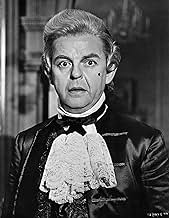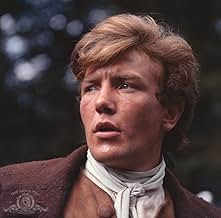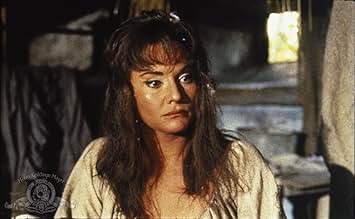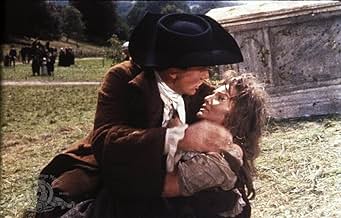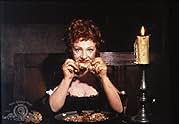CALIFICACIÓN DE IMDb
6.4/10
15 k
TU CALIFICACIÓN
Las románticas y caballerescas aventuras del bastardo adoptado Tom Jones en la Inglaterra del siglo XVIII.Las románticas y caballerescas aventuras del bastardo adoptado Tom Jones en la Inglaterra del siglo XVIII.Las románticas y caballerescas aventuras del bastardo adoptado Tom Jones en la Inglaterra del siglo XVIII.
- Dirección
- Guionistas
- Elenco
- Ganó 4 premios Óscar
- 20 premios ganados y 20 nominaciones en total
- Dirección
- Guionistas
- Todo el elenco y el equipo
- Producción, taquilla y más en IMDbPro
Opiniones destacadas
Just two hundred years after Henry Fielding's novel appeared, the theatre-actor-turned-cinema-director Sir Tony Richardson rounded up a few Shakespearean-trained prodigees, got John Addison to compose hectic clavichord accompaniment a little in the style of Handel operas and set all this against lush photography to produce one of the most hilarious films of the last five hundred years. Fielding's novel which is a most definite recommendation rather cynically but good-humouredly exposed mid-eighteenth century British hypocrisy at its best and the landed gentry's obsession for fox-hunting at its worst. Richardson directed all this a bit like an elderly Sir Thomas Beecham ('the important thing is we all start and stop together; nobody notices what happens in between') raising his baton in front of the London Symphony Orchestra: the result in both cases is astounding. Richardson conducts his piece at a tremendous pace, Addison's clavichord tripping along gaily so as to keep up the illusion, and visual sequences such as a young trouserless Albert Finney escaping out of a window, shinning down a tree and running off into the nocturnal depths of a beech forest, all combine to keep you breathlessly awaiting the next scene. Susannah York is just delicious, with that innocent facial beauty that raises heartbeats, especially in the latter parts; and Angela Baddely as Mrs. Wilkins and Diane Cilento as Molly play some great scenes. And some of the great scenes are worth telling...... Tom and Mrs. Wilkins enjoy a good roast with fruit, eating lusciously and lascivously, eating each other up with their sparkling eyes: this scene is hugely delightful. The other great scene is the fox-hunt: this alone puts the whole film into a special category: brilliant film-making, almost comparable to the famous chariot race in Ben Hur........ I loved this film 37 years ago, and recently had the luck to see it again: having doubled my years, I was just as enthralled and enraptured as the first time. A splendid piece of art.
A fun and fresh screen adaption of British writer Henry Fielding's 18th Century novel of the same name, made at the threshold of the swinging (19)Sixties. Like the original story's French counterpart (Les Liaisons Dangereuses=Dangerous Liaisons), at its heart is a mannered metropolitan love triangle.
But before we arrive in the heart of London the stage is set amidst the lush green English countryside in Summer. Here we first meet the protagonist, Tom Jones, played by Albert Finney in his most youthful bloom, and his extended family representing every facet of post-Glorious Revolution England.
An incorrigible ne'er-do-well, Tom's genuine love for his neighbor Squire Alworthy's daughter Sophie (a very lovely Susannah York), takes him to the heart of fashionable London society in a series of comedic wrong-turns and misunderstandings. Here he becomes embroiled in the games of the jaded aristocrat Lady Bellaston played by Joan Greenwood. Greenwood steals the show as the original Mrs. Robinson and, through her machinations, Tom is led to the gallows. But at the last minute...
Throughout the movie is paced with a modern sense of realism, made effective by hand-held camera sequences and the quick editing of Antony Gibbs. Old-fashioned film techniques are used effectively with eye-to-the-camera realism, and convey an up-to-date feel. There are moments of beauty as well as comedy in this very satisfying entertainment. The cast is stellar with many familiar names--Hugh Griffith, Rachel Kempson, David Warner (in his first movie), the settings realistic, and the the musical score a perfect fit. A great time overall!
An interesting note, supposedly this is the last movie seen by John F. Kennedy (in a White House screening) before he was assassinated.
But before we arrive in the heart of London the stage is set amidst the lush green English countryside in Summer. Here we first meet the protagonist, Tom Jones, played by Albert Finney in his most youthful bloom, and his extended family representing every facet of post-Glorious Revolution England.
An incorrigible ne'er-do-well, Tom's genuine love for his neighbor Squire Alworthy's daughter Sophie (a very lovely Susannah York), takes him to the heart of fashionable London society in a series of comedic wrong-turns and misunderstandings. Here he becomes embroiled in the games of the jaded aristocrat Lady Bellaston played by Joan Greenwood. Greenwood steals the show as the original Mrs. Robinson and, through her machinations, Tom is led to the gallows. But at the last minute...
Throughout the movie is paced with a modern sense of realism, made effective by hand-held camera sequences and the quick editing of Antony Gibbs. Old-fashioned film techniques are used effectively with eye-to-the-camera realism, and convey an up-to-date feel. There are moments of beauty as well as comedy in this very satisfying entertainment. The cast is stellar with many familiar names--Hugh Griffith, Rachel Kempson, David Warner (in his first movie), the settings realistic, and the the musical score a perfect fit. A great time overall!
An interesting note, supposedly this is the last movie seen by John F. Kennedy (in a White House screening) before he was assassinated.
In 1963 two of the most important productions in the history of movie making were released. The first was: "Cleopatra" with Richard Burton and Elizabeth Taylor, a cast as long as the Manhattan telephone directory and a budget bigger than the combined egos of the stars. "Cleopatra" was a total disaster. It has no redeeming quality that I know of. It is therefore important for embodying in one film, nearly everything that you can do wrong in making a movie. It is a movie that you must see if you are ever to understand what a truly good film really is. The second was: "Tom Jones" with Albert Finney and Susannah York, shot with rented equipment and costumes on the streets of London with a supporting cast of brilliant British ensemble players and extras who stood-in just to get in a film. Tom Jones is simply one of the best motion pictures of all time, for my money, The Best from Literature.
John Osborne who wrote the screen play produced a marvelous vehicle, but the genius of "Tom Jones" is Tony Richardson. He moves the actors and the story about the screen with a bawdy grace and earthy gentility that paints action and raucous laughter and beauty across one another with an even hand. It is a glimpse of antiquity so close and real that we can nearly touch it, and it makes us want to. (Though to be perfectly honest, I'm not sure we'd care for the smell of it.)
"Tom Jones" is a low budget, low tech, high quality film that must win the award for the "Most with the Least." The photography is beautiful, not because it used a dozen half million dollar cameras, it is beautiful because it is good photography. The acting wins out, and casts of thousands would only serve to clutter the stage. See this film whenever, wherever and as often as you possibly can.
John Osborne who wrote the screen play produced a marvelous vehicle, but the genius of "Tom Jones" is Tony Richardson. He moves the actors and the story about the screen with a bawdy grace and earthy gentility that paints action and raucous laughter and beauty across one another with an even hand. It is a glimpse of antiquity so close and real that we can nearly touch it, and it makes us want to. (Though to be perfectly honest, I'm not sure we'd care for the smell of it.)
"Tom Jones" is a low budget, low tech, high quality film that must win the award for the "Most with the Least." The photography is beautiful, not because it used a dozen half million dollar cameras, it is beautiful because it is good photography. The acting wins out, and casts of thousands would only serve to clutter the stage. See this film whenever, wherever and as often as you possibly can.
While my mother claims this is a "guy movie," I'm not a guy and find it one of the funniest, most charming movies ever made. The narration, music and just plain spunky tone of this movie makes it a unique piece -- you really DO have to see it to understand what it's all about! I highly recommend this movie -- as well as the book, which was published in 1749 but is just as funny today and highly readable, not "quaint" at all!
I find it almost impossible to believe that there are people out there that did not find movie hilarious. There are so many memorable scenes, so many wonderful lines and such great acting! This is easily one of the most entertaining movies I've ever seen, and definitely the most entertaining British film. It gets a perfect 10.
Oscars Best Picture Winners, Ranked
Oscars Best Picture Winners, Ranked
See the complete list of Oscars Best Picture winners, ranked by IMDb ratings.
¿Sabías que…?
- TriviaIt took two nights to film the sequence in which Squire Western chases after Tom. The second night, Hugh Griffith managed to undo the wiring on his riding crop, and actually hit Albert Finney with it, drawing blood. In character, Finney turned on Griffith and said, "I can't abide to be whipped, Squire," then punched him in the face. Each stalked off the set, swearing never to work with the other again.
- ErroresAfter Lady Bellaston reads Tom's letter proposing marriage, she wads it into a small ball. Lady Bellaston later shows the letter to Sophie's aunt, but it is now smooth and uncrumpled.
- Créditos curiososOpening credits: In the west of England there was once a Squire Allworthy. After several months in London he returned home. his sister, Bridget. his servants. after supper. "Mrs. Wilkins!" "aaah!" a baby! abandoned!!! "how did it get here?" "who can the mother be?" "Jenny Jones!" "who is the father Jenny?" "send for Partridge the barber!" Partridge the barber - the father? "I will deal with you later, sir!" "you must be sent away from this shame and degradation." "as for your child . . . . . " "I will bring him up as if he were my own son." "what will you call him brother?" "Tom Jones." of whom the opinion of all was that he was born to be hanged.
- Versiones alternativasFor the 1989 reissue/restoration, the director trimmed approx. 7 minutes from the original. The initial home video release in 1981 on the Magnetic Video label contains the full-length original, which includes the following footage/dialogue cut from the reissue:
- Tom running from Squire Western; Black George caught for killing sheep; trial
- Sophie: "Oh, my little bird."
- Molly being called a slut by her family: "You will have a bastard"
- Tom/Sophie montage: Tom reading, eating nuts, picking berries, Tom and Sophie singing
- Teachers fighting Tom; Tom going around tree; riding teacher
- Tom's dream at the Inn
- Sophie and Lady Fitzpatrick: Trimmed frames from laughing
- Sophie and Lady Fitzpatrick: "What will you do in London?" "I have a friend..."
- Sophie and Lady Fitzpatrick: "What about your friend?" "He is away for a few days. When he returns we shall make other arrangements."
- Lady Bellaston and Lady Fitzpatrick: "The girl is obviously intoxicated and nothing less than ruin will content her."
- Lady Bellaston muttering French phrase at dinner
- Lady Bellaston: Dialog after "Are you afraid of the word 'rape'?"
- Transition from Bellaston and Fellamore to Tom and Partridge
- Transition from Tom and Partridge to "Rape"
- Partridge and Tom: "She'll be the one to break it off"; transition to note; dialog: Narrator reads letter, Bellaston remarks to maid not to receive Tom Jones again.
- "Scandal are the best sweeteners of tea."; transition
- Partridge looking for people to uphold Tom's character (in the original he approaches one man, then two more - scene of him approaching the first man was cut)
- No reprise of song for Tom as he's going to be hanged
- End titles (re-done for reissue with restoration credits and extended music by 15 seconds, while cutting some of the original company credits)
- ConexionesFeatured in Precious Images (1986)
Selecciones populares
Inicia sesión para calificar y agrega a la lista de videos para obtener recomendaciones personalizadas
- How long is Tom Jones?Con tecnología de Alexa
Detalles
Taquilla
- Presupuesto
- USD 1,000,000 (estimado)
- Tiempo de ejecución2 horas 9 minutos
Contribuir a esta página
Sugiere una edición o agrega el contenido que falta

Principales brechas de datos
By what name was Tom Jones, hombre de audacia (1963) officially released in India in English?
Responda


